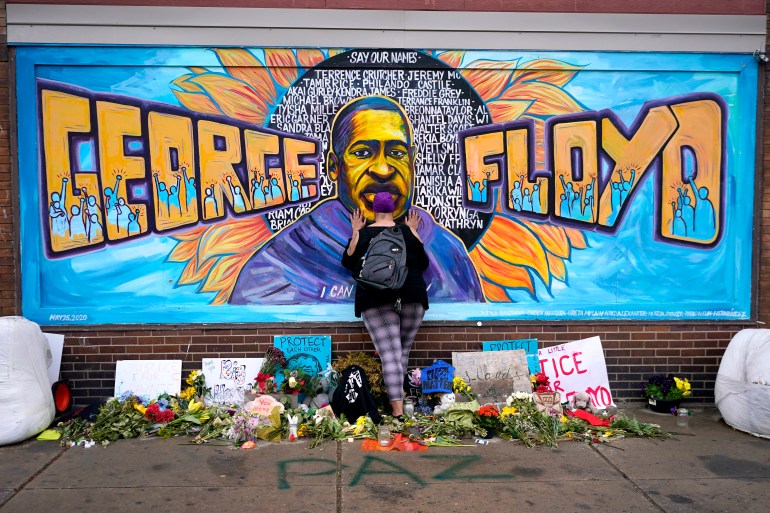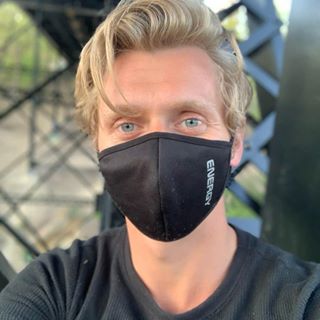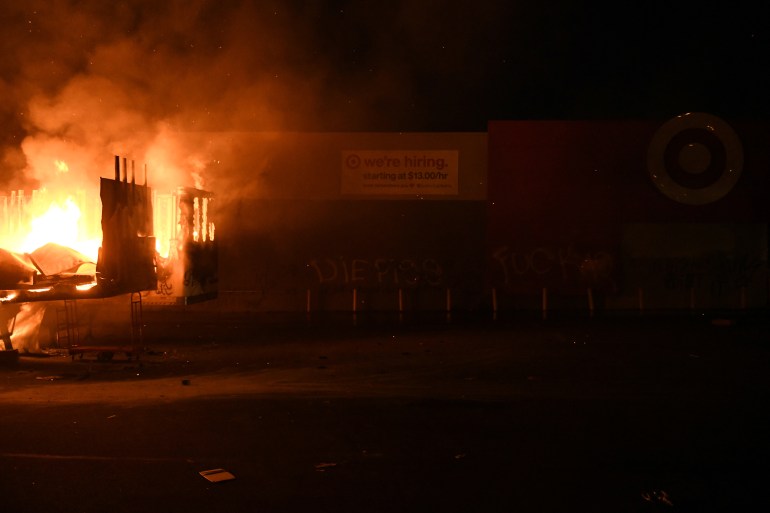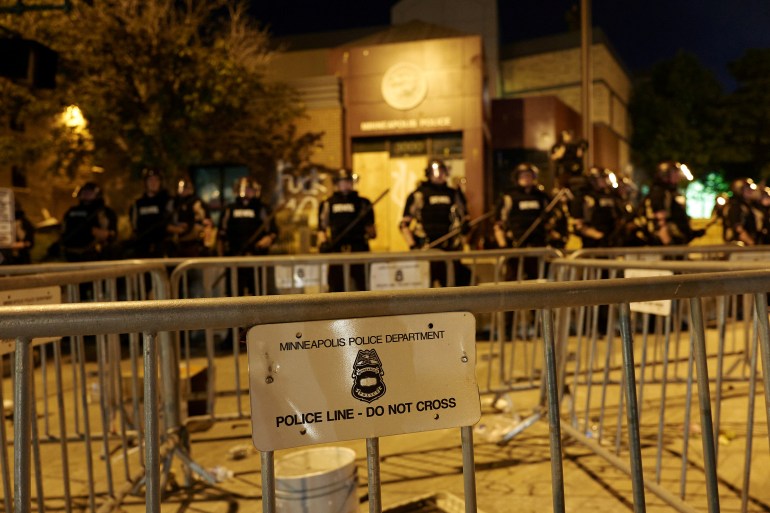Protester at BLM rally on why he took part in Minneapolis arson
Branden Wolfe tells Al Jazeera about his struggles with mental health, meeting George Floyd, in an exclusive interview.

Branden Wolfe had hoped for a lighter sentence. Federal authorities accused him of conspiracy to commit arson in the burning of a police building in the days following the death of George Floyd.
Authorities alleged he “pushed a barrel into a fire located in the entrance of the third precinct headquarters”, fuelling the fire. A judge gave him a prison sentence of 41 months for the crime.
Keep reading
list of 3 itemsVideo shows Chicago man shot by police in back, had gun
Activists: Drop all charges against Minneapolis protesters
But Wolfe, 23, told Al Jazeera in an exclusive interview he does not feel guilty of the charge.
Wolfe said he did not “conspire” to commit arson with four others charged when he rolled a wooden barrel into the burning precinct, though he said he does regret his actions that evening. Undiagnosed mental health issues and tumultuous personal life – including years of homelessness – influenced his actions, he said.
He had hoped these circumstances would persuade the judge to issue a lighter sentence, even supervised release, after he pleaded guilty in January.
Acting US Attorney Anders Folk said in a statement that “Wolfe furthered the destruction” in Minneapolis “last summer by literally adding fuel to the fire”.
“In addition to the arson, Mr. Wolfe stole body armor, weapons, and ammunition belonging to the Minneapolis Police Department,” Folk continued. “This sentence underscores the seriousness of Mr. Wolfe’s actions and holds him to account.”
Wolfe said he could not comment on the allegations of theft, as the case is ongoing, but said he wanted to set the record straight on his mental state, which motivated his actions, and his views on violent protests when he spoke to Al Jazeera before the May 4 sentencing.
“I’ve seen articles accusing me of being part of the Boogaloo Bois. I’ve seen YouTube videos and posts on Instagram saying I’m part of the KKK or I’m a white supremacist and my goal was to frame Black Lives Matter as a collective for the arson of the precinct,” Wolfe said.
“None of that is true.”
‘George Floyd was an awesome man’
Floyd died while former Minneapolis Police officer Derek Chauvin held his knee on the Black man’s back for more than nine minutes on May 25, 2020, sparking a global protest movement against police brutality and racism.
A jury found Chauvin guilty of unintentional murder and manslaughter on April 20.
Wolfe had tumultuous adulthood leading to the precinct’s burning on May 28, according to court documents and Wolfe’s telling of his life story.
“I was homeless,” Wolfe said. He left his home in Florida at the age of 18, chasing a “mutually toxic and unstable relationship between two immature young people”, documents say.
Wolfe was on the move for several years, living in cars, homeless shelters and elsewhere in Mississippi, North Carolina, Georgia and Tennessee.

He followed the mother of his child to Minnesota in 2019. Wolfe sought help for substance abuse in Minneapolis, but remained unsheltered “until April of 2019”, Wolfe said.
He would frequently visit the Salvation Army Harbor Light Center, a homeless shelter that provides free meals to the needy, where Floyd worked as a security guard.
“I was a regular [there], five days a week for breakfast, and I saw him quite a few times,” he said. Wolfe said he did not consider himself Floyd’s personal friend, but they had a relationship that grew out of regular chats at the shelter.
“You can tell when people struggle with things, just by communicating with them. Obviously, he did. I did, too. That’s life. But, I mean, George Floyd was an awesome man.”
A difficult time
Floyd’s death, caught by bystander video and widely shared, hit Wolfe during a difficult time he said.
The COVID-19 pandemic had caused him to lose two jobs. His daughter was placed in the care of another family, and he could only see her “twice a week … everything just fell apart”.

Wolfe lived with undiagnosed bipolar disorder until he received treatment while in detention in June 2020. He was in the middle of a prolonged manic state when protests over Floyd’s death erupted in Minneapolis, he claimed.
People experiencing mental illnesses are convicted at a higher rate than they appear in the general population. According to the National Alliance on Mental Illness (NAMI), 37 percent of people imprisoned in state and federal prisons experience mental illness.
That is more than the 20.6 percent of US adults who experienced mental illnesses in 2019, according to data cited by NAMI.
“[P]eople with mental illness frequently encounter police rather than get medical attention”, according to NAMI. “As a result, people with mental illness are over-represented in the criminal justice system.”
Wolfe said he did not initially recognise Floyd in the video, but the day after it became public and Floyd was identified, “The mania went from, like, 60, to 1,000, real quick.”
Floyd was killed on a Monday. Large crowds began marching to the third precinct, and by Wednesday, the law enforcement facility was burned.

From “Wednesday until Saturday morning, I never went home”, Wolfe continued.
Wolfe said he followed the demonstrations to the precinct, enjoying the feeling of belonging it provided, which is attractive to someone in a manic state.
He saw police officers were using less-lethal munitions, including tear gas and baton rounds, as demonstrations escalated outside the precinct, Wolfe said.
“You could see officers who really enjoyed what they were doing and officers that looked dead inside, like they didn’t have a soul.”
Reform, not violence
The topic of police reform – and abolition – has been on the minds of activists and policymakers since Floyd’s death.
As Chauvin stood trial, several police killings of Black people sparked further controversy, including the death of Daunte Wright in Minneapolis suburb Brooklyn Center.
Even after Chauvin was convicted, Minneapolis activists arrested at protests throughout the year told Al Jazeera their resolve to push for reforms was strengthened.
Rob Lewis, a teacher arrested in November, told Al Jazeera he wants “to abolish the police because it’s an oppressive force”.

But Chauvin’s conviction gave Wolfe hope for a more moderate change.
“I hope that this conviction, and this [George Floyd Justice in Policing Act], passes,” he said, referring to a policing reform bill that would require anti-discrimination training for law enforcement agencies that receive federal funding and limit the use of deadly force for federal officers.
“Maybe then some of the anger will subside and our communities can actually prosper to some degree.”
Regarding violence: “I see this as destructive to the community, not constructive to the movement.”